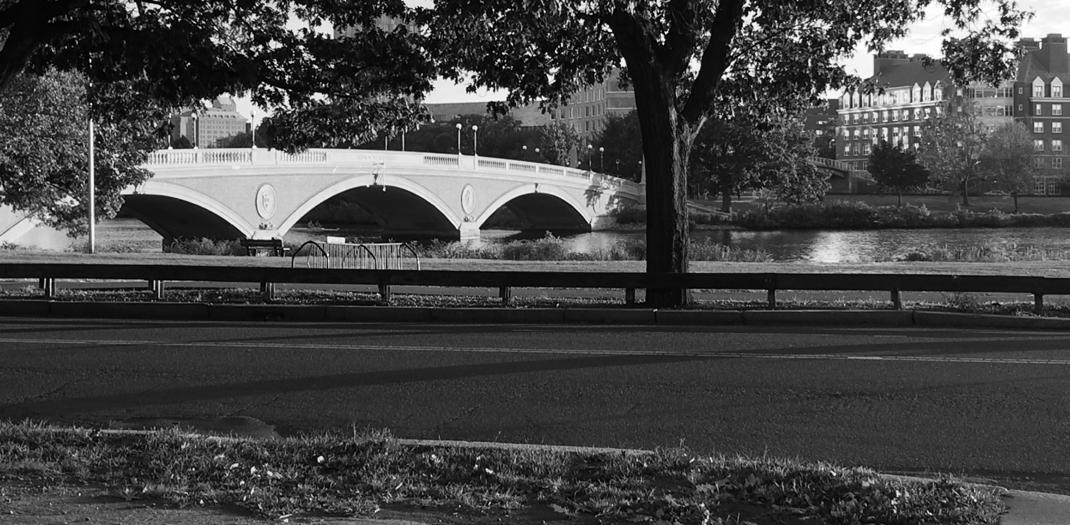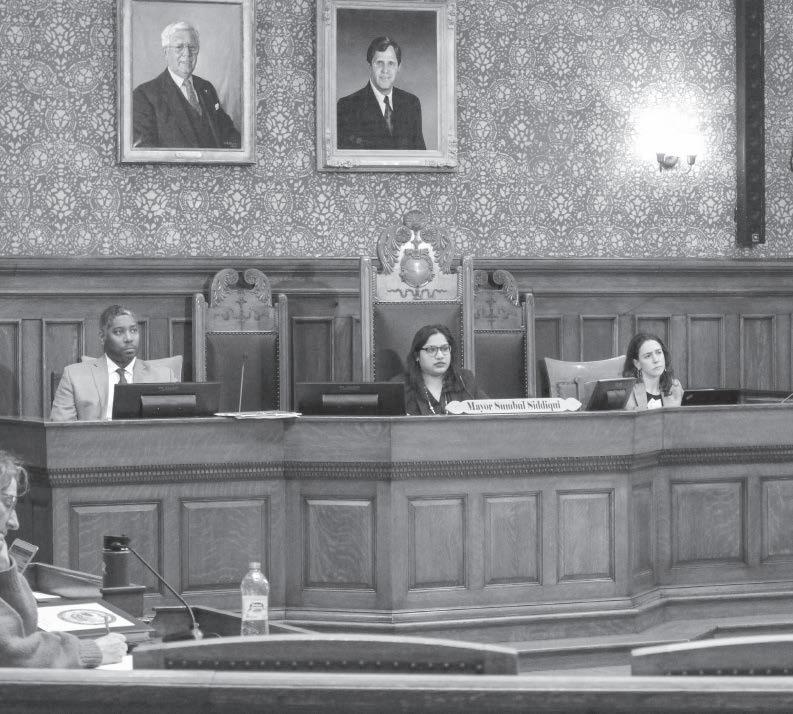THE HARVARD CRIMSON | FEbruary 11, 2020
Page 4
Editorial The Crimson Editorial board
column
Who Says Teens Shouldn’t Vote?
The Conservative Case for Divestment Protest
A
s recently as 1971, Harvard students under 21 were still fighting for the right to vote. That probably seems absurd now. Which raises the question: In another half-century, will it be equally absurd that 16- and 17-yearolds can’t vote now? Last week, Cambridge City Council voted in favor of allowing citizens aged 16 and older to vote in Cambridge elections for city council, school committee, and local ballot measures. The home rule petition has been forwarded to the Massachusetts State Legislature and requires its approval before 16- and 17-year-olds can, contra Mass. state law, vote in Cambridge elections. This marks the third time that the Cambridge City Council has proposed lowering the voting age, with the previous two in 2002 and 2006 ultimately failing in the state legislature. The difficulty faced by the proposal matches a perva-
Which raises the question: In another half-century, will it be equally absurd that 16- and 17-year-olds can’t vote now? sive national skepticism about lowering the voting age. In a recent poll, a majority of registered voters opposed lowering the voting age, and when Mass. Representative Ayanna Pressley proposed doing so as part of a voting rights bill, the amendment failed 126 to 305, with opponents expressing doubts that 16-year-olds had sufficient maturity. It follows that only Takoma Park, Md. has granted 16- and 17-year-olds the municipal right. While the disenfranchisement of young people is certainly not analogous to this discrimination of people of color, a lack of maturity seems to be a weak
argument that makes apparent a profound historical myopia. Racist limitations on suffrage have historically taken their most insidious forms as poll taxes and literacy tests, which were meant to bar black voters by taking advantage of their reduced economic means and limited access to education. It would take the Voting Rights Act of 1965 and the 24th Amendment, ratified in 1964, to legally abolish these forms of discrimination. As a society, we rightly came to acknowledge that notions of voter quality or qualification are more often than not masks, easy ways to disenfranchise people whose voice is perceived by those in power as a threat. Our society functions on the principle that individuals should have the right to collectively select their representatives in local, state, and federal governments, holding them accountable through regular and frequent elections. Expansion of those rights, therefore, merit serious discussions and reflections. As such, we support granting 16- and 17-year-olds the vote, especially on the local issues that directly affect them, not on grounds of their capacities but on the grounds that it is their right to do so. Still, we believe that granting young people the right to vote is a great opportunity to increase their civic awareness and engagement more broadly. Alongside this new civil liberty, Cambridge schools should spend more time teaching civics to help students make informed decisions at the ballot box. We commend the work that the Harvard Civics Program has done in that area. Moreover, beyond first-principle arguments, we believe that lowering the voting age in local elections also provides practical benefits for local politics. Currently, many people are introduced to politics when they come of age in college, and, as a result, most of their attention is likely focused on national issues
and their accompanying brouhaha, often at the cost of important local politics. The average local election draws one in every five voters, and 99 percent of respondents in an average media market never look at local news sites. If young people were introduced to politics at the local election before leaving home, they might well come to appreciate and form long-term and mean-
As a society, we rightly came to acknowledge that notions of voter quality or qualification are more often than not masks, easy ways to disenfranchise people whose voice is perceived by those in power as a threat. ingful engagements with local politics, which many would argue carry more significance and impact than national elections anyway. Lastly, as we champion the enfranchisement of young voters, we would be remiss if we fail to recognize the many people — noncitizen residents, undocumented residents, incarcerated citizens, or ex-felons — who do not have the right to vote. Equally, they deserve a say on matters that affect them, and the deprivation of their rights is a stain on our democracy. This staff editorial solely represents the majority view of The Crimson Editorial Board. It is the product of discussions at regular Editorial Board meetings. In order to ensure the impartiality of our journalism, Crimson editors who choose to opine and vote at these meetings are not involved in the reporting of articles on similar topics.
Submit an Op-Ed Today!
The Crimson @thecrimson Op-ed
The Lowell Legacy Revisited By A. J. VENEZIANO
T
he iconic bell tower of Lowell House looms over the campus, reminding students every day of the greatness of President Abbott Lawrence Lowell, Class of 1877. In addition to this tower atop the imposing upperclassman house, hundreds of students flood into Lowell Lecture Hall for class and rehearsals. Evidently, the Lowell legacy is eternalized on this campus, regardless of whether students really know who the man himself was. However, Lowell’s actions in the early twentieth century raise questions as to whether he is deserving of the high praise the University bestows upon him to this day. In 1922, President Lowell recommended to the Board of Overseers a quo-
So, should Lowell House be renamed in order to cease honoring Abbott Lawrence Lowell? ta system to be placed upon Jewish applicants. In the wake of the mass immigration of the 1920s, Lowell evidently was threatened by the premise of a challenge to the historically Christian, Anglo-Saxon tradition of Harvard. Additionally, he denied housing accommodations to multiple African American students, claiming that “from the beginning, we have not thought it possible to compel men of different races to reside together.” Recently, it was discovered that President Lowell led a cutthroat crusade against gay students in 1920. In what is now referred to as the “Secret Court of 1920,” Lowell and Acting Dean of the College Chester N. Greenough found 14 men “guilty” of partaking in homosexu-
al acts on campus, including seven College students who were subsequently expelled and asked to leave Cambridge. The main substantial evidence came from the students’ attendance at the lavish parties held by Ernest Roberts in Perkins Hall 28. Following the guilty verdict, two students committed suicide and the rest were left blacklisted from other universities. This year is the one-hundredth anniversary of their expulsions. One could imagine the level of discomfort for a BGLTQ student, Jewish student, or student of color living in the house of the man who wanted them banished from campus. During the recent renovation, the Faculty Deans of Lowell House, David I. Laibson ’88 and Nina Zipser have encouraged removing a bust of Abbott Lawrence Lowell from the courtyard, and the portraits of Lowell and his wife were removed from the dining hall. The dining hall is a space to foster community among Lowell residents, and the new deans decided that President Lowell did not belong there. While the portrait of Lowell has left, one can find a portrait of his sister, Amy — a notable lesbian, Pulitzer-prize winning poet, hanging there. This seems to be an apt replacement of the openly homophobic president. Furthermore, Lowell House is creating a committee to research Lowell and ponder how to grapple with his complicated legacy today. So, should Lowell House be renamed in order to cease honoring Abbott Lawrence Lowell? I believe this is not necessary, since the House represents the entire Lowell dynasty, not just the president from the early twentieth century. As one prepares to leave the House, the bust in the courtyard of James Russell Lowell, an important abolitionist poet from the 1800s, can clearly be seen on its pedestal. Furthermore, the portrait of John Lowell, the Massachusetts law-
yer who helped draft the 1780 Massachusetts constitution, leading to the abolition of slavery in the state, hangs proudly in the House. To erase their name from the building would be erasing their legacy as well. However, an interesting conflict remains: The University has not taken the same steps to change Lowell’s legacy as Laibson and Zipser have done as deans.
To erase their name from the building would be erasing their legacy as well. In fact, in the Faculty Room in University Hall, President Lowell is one of few individuals to be memorialized twice — in a painting and a bust. Interestingly enough, the bust was sculpted by John Wilson, the artist responsible for the “Silent Sam” statue that led to immense controversy at the University of North Carolina. Henceforth, I call upon the Harvard administration to follow in the steps of the Lowell House deans and halt the excessive memorialization of Abbott Lawrence Lowell. Ceasing to memorialize a figure is not the same as erasure; taking this step simply says that this figure is not worthy of our adoration. As a queer student, it frustrates me to know that the Faculty Room has a proud bust of the man who would have abhorred my presence in the Yard. Removing the bust — if not the painting as well — is a necessary start to atoning for a shameful part of this institution’s history. Until then, the Lowell bell tower will continue to chime as time passes while the individuals Lowell destroyed are forgotten. —A.J. Veneziano ’23 lives in Canaday Hall.
Eric Yang plain truth
T
he timeless tension in politics, that liberals think conservatives are evil, and conservatives think liberals are stupid, manifests itself once again in the current debate over divestment and the merits of protest. Between the clamors for climate justice and the complete condemnation of divestment’s goals and methods, I believe it is important to articulate a moderate position that attempts to clarify some of the underlying logic of both sides and work to bridge this disagreement. To have a contained discussion of divestment protest, here are three assumptions that I take for granted: firstly, that global warming is a serious issue that warrants immediate, thoughtful action; secondly, that divestment is one of many means for the University to address this issue; finally, that there are better means for the University to address this issue. I omit any discussion of my thoughts on the final assumption, the major source of contention on campus, precisely because it is so over discussed. It is my view that this emphasis on divestment misses a key point about divestment protest, and one of its greatest merits — that it is not just an argument about the merits of divestment, but a clarion call for climate action in general. I am against divestment, but for divestment protest. The disruption caused by divestment protest is an essential part of this greater argument for action. The disruptive nature of the divestment protest invites comparison to other disruptive protests and debates over their moral equivalency. Why isn’t the divestment protest like the Vietnam protest or the divest South Africa movement? The moral argument implied by disruptive protest is not only the scapegoating of an authority figure, as some might argue, but more importantly, a general indictment of the complicity of the greater community for perpetuating the status quo. The sin of the greater Harvard student community is not the commissioning of funds for investment, but the sin of inaction. President Bacow’s call for the protesters to utilize the proper and less disruptive channels of influence misses the effectiveness and significance of this moral argument respectively. On the first point, while institutions can effect change in gradual, systematic ways, they also have every ability to thwart change in a gradual, systematic manner. President Bacow can organize any number of proper committee meetings, faculty votes, and community-based discussions that result in the continuation of the status quo. This capacity for delayed change, however, is not the fault of institutions as a whole, but the very strength of their design. Harvard cannot, and should not, immediately implement the next good idea that comes along, no matter how many undergraduates support it. This is because institutions are not independent, or even democratic, actors that can choose to “do the right thing,” but complex multi-headed systems with defined lines of accountability and express limitations on what they can do. Intractable, “evil” institutions make effecting change more difficult, but reversing it even harder, and thus help to create the ideological consistency necessary for lasting, structural change. However, it is precisely because of their general tendency towards inaction and the maintenance of the status quo’s rate of progression that on important issues which require immediate action, like global warming, decisive pushing is necessary to reorient institutions towards the correct path. Divestment protest has shifted the discourse in Harvard to center around concerns of global warming; so much so that the president of the Harvard Republican Club has publicly advocated his own solutions to the environmental crisis. The effect of discourse shifting and conscience raising is not an abstract intellectual accomplishment. While President Bacow is right to say that there are other, better ways of saving the planet, his claim indicates that the protesters have successfully asserted the importance of their call for action. A strong call to action is necessary to effect even the most moderate, reasonable change because as conservatives know, the institutional reluctance to “do the right thing” applies to its calculus of economic cents, common sense, and moral obligation. Despite the obvious appeal and almost universal support among economists for ideas like carbon dividends, Congress has still yet to implement them, in part because none of the respectable economists who endorse carbon dividends will disrupt a presidential address to demonstrate their support for them. The “dumb” liberals, nay the “dumbest” liberals, have often played an instrumental, if underappreciated role in creating the moderate, positive social change that most people desire. The conservatism that I advocate for — the conservatism that supports divestment protest, but not divestment — is rooted in a deep skepticism of the most intractable institutions as well as the best of intentions. The universe will bend itself towards justice, but it shouldn’t bend with the exact curvature and rate that the divestment protestors want it to. —Eric Yang ’22, is a History concentrator in Leverett House. His column appears on alternate Tuesdays.




